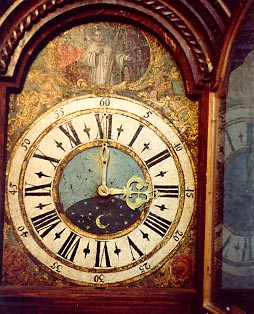BACK
Church Sacristy Clock
 Bought in 1943 in Graz, Austria, from an art and
antiques Dealer. Bought in 1943 in Graz, Austria, from an art and
antiques Dealer.
Hand-carved lindenwood.
Purpose: Timing
preparations for mass.
The clock stood close to a place in a sacristy where the incense kettle was
fired up.
Religious ornaments:
Rooster crowing, on the top of the door
Crown of thorns at center of door.
Age: The style of
painting of the face shows 1720 or older
The style of carving is later - renaissance.
Height: 8'
8"; depth: 9"; width 13".
Function: Chime
and movement for daily rewind.
When bought, the clock smelled intensely
of incense. This and the religious symbols point to the use of the clock in a
sacristy.
Note: Because of
the size of this piece, the pictures were more easily made with the clock lying on the floor. Individual sections were able to be photographed orthogonally. The
resulting picture collage resulted when the resulting prints were scotch-taped together.
When assembled, the clock stands on its own to a height over eight feet. Movement,
pendulum and weights (not shown) are included, the clock runs and must be wound daily.
Further information:
(Source: Gerhard
Hüttler - Uhren Juvelen -- Wien, Auhofstrasse 181. 12.12.1994)
"These clocks were made, mostly by smiths, in the Lower Austria area, also
in Styria between 1650 and 1850. The decoration of the dial clearly refers to a
clerical order (Monastery, Parsonage, etc.) Pendulum and weights have been restored later.
The carved case also indicates an ecclesiastic placement, sacristy, monastery.
However the case is typical for the period of the 19th century (production about 1860 -
1890). Characteristic therefore is the unbalanced decoration (Braiding pattern of
the socle and shingled step gable are such sings).
Signed: Gerhad
Hüttler"
|

